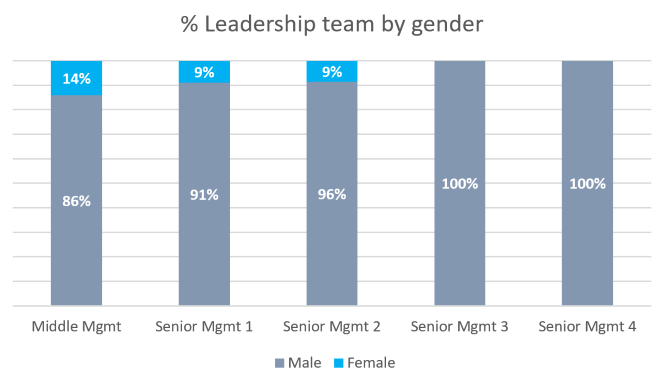Leading the Fintech Industry in Gender Diversity | Best Practice by Avaloq
Avaloq is a global leader in digital banking solutions, core banking software and wealth management technology. Over the past 20 years, we have grown into a CHF600 million revenue business employing more than 2,000 highly skilled people around the world. Our solutions are used by 160 of the world’s largest financial institutions – including HSBC, Deutsche Bank, Maybank, DBS Group and Barclays. Our headquarter is based in Zurich.
This best practice was first published in the Gender Intelligence Report 2020.
The fintech industry is notoriously male dominated. The average percentage of women in the software industry is only 29%. This needs to change, and fast. Why? Because diversity in the workplace leads to higher levels of creativity, innovation and productivity, which ultimately increases stakeholder value. Our solutions are used by banks and wealth managers all over the globe, but most importantly, by people. These solutions must work intuitively and reliably, across all sizes and areas of financial institutions, in many cultures, used by all genders. In order to best serve our diverse client community, we rely on a workforce that is just as diverse.
With this in mind, Avaloq is setting itself targets and taking practical steps to improve gender diversity at all levels – with the aim of leading the global fintech industry.

Chief Human Resources Officer at Avaloq
![]()
At the end of 2019, 25% of our 1,380-strong workforce in Switzerland was female, compared with 29% (2,035) globally, which presents us with a significant gender imbalance. The gender imbalance is seen most starkly at leadership levels. As the graph shows, the higher the grade, the lower the percentage of women. The Board of Directors comprises seven members and not one of them is a woman.

As an employer, we strive to pay fair salaries. In order to ensure fair pay, all positions are evaluated based on a grading methodology provided by an external service provider, which allows us to compare positions of similar job scope and to determine salaries in light of market practice and to ensure internal equity.
We analyse pay on a regular basis. The mathematical result of the gender pay-gap analysis showed that, on average, women’s salaries were 0.8% lower than men’s. Although we are proud that our gap is relatively small, we carefully review areas where average salaries are considerably higher for one gender than the other.
We also monitored the gender distribution in relation to career-growth moves. On average, male employees work in positions with a higher grade. In order to boost our female employees’ development, we take careful decisions about who to consider for a career-growth move at Avaloq.
Our Global Policy on Diversity and Equal Opportunity sets out minimum standards and measures to provide equal employment and advancement opportunities for all employees. However, as everyone knows, it is not enough just to have a policy.
As with many businesses in finance and technology, we recognize there is a gender imbalance that we need to address at all levels through our recruitment, training and retention strategies.
Various teams and committed individuals have joined forces and set three targets, mapped out the process, and zeroed in on the partners and stakeholders to help us on this journey.
Finally, when it comes to challenging the dichotomy between part-time and full-time employment, many departments are offering the option to work flexibly with different contracted hours (i.e. 40%, 60%, 80% of full-time hours). We proactively promote sabbaticals and we have a new flexibility to accommodate working from home that was not possible before.
This paradigm shift implies a change in evaluating the work done, with a focus on performance over physical presence, thus increasing employee dedication.
This Best Practice was first published in the Gender Intelligence Report 2020.

Discover how EY is leading a paradigm shift in the workplace by embracing flexible working arrangements. Explore their innovative strategies for getting clients on board with this transformative approach, fostering collaboration and driving business success.

NatWest champions working families through their comprehensive initiatives, such as Partner Leave, Phase-Back Program, and a Remote First approach. Uncover how they lead in creating a gender-balanced and inclusive environment that supports employees' specific needs.

Experience KPMG's commitment to empowering employees through flexibility and work-life integration. Discover their diverse initiatives challenging traditional norms and supporting new parents, fostering a thriving workplace for all.

Step into ABB's world and witness their groundbreaking gender-neutral parental leave program. Discover how ABB fosters a gender-balanced and inclusive environment, breaking boundaries and paving the way for working families to thrive.

Discover how Migros revolutionizes the workplace with its commitment to work-life integration. Explore their emphasis on part-time positions, hybrid work models, and leadership support, creating an environment where employees can flourish.

Implementing a holistic 4 pillar pay equity framework led to decreasing the pay gap to under 1% - and keeping it there.

Leaders insisting on pay equity and undertaking serious independent analyses builds trust and a culture of inclusion.

A customised internal salary modelling tool ensures fair salaries and strengthens employee confidence.

The full pay flexibility deal allows new parents to decide how they want to manage the transition back to work.

Looking beyond data helps Syngenta make pay equity a fundamental element of the company's culture rather than just a project to tick off.

Chances for promotions are equal for full-time and part-time employees thanks to a strong culture of flexible working.

#sharethecare shifts the narrative from ‘caregiving is strictly a woman’s responsibility’ to ‘caregiving is for both parents’. A bold ambition aiming to cultural change.